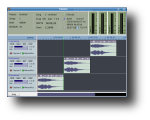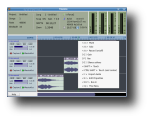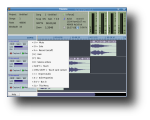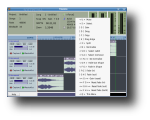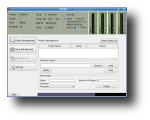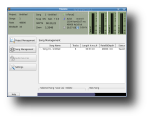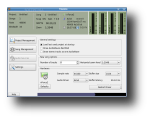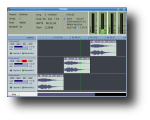For a long time, multimedia support in Linux was either totally missing or weakly implemented. Nowadays, audio and video decoding has been fully implemented and using one of the many good audio and video players, you can play just about any media format available out there. I'm not saying multimedia support in Linux is now complete and flawless but its development is going on the right track and I truly believe, someday, we will be able to watch movies, play games and listen to music just as easily as on a Windows machine. Until then, let's see what's new in the multimedia section. For a long time, I was looking for an audio recording and editing tool for Linux that's easy to install and use. I've found several such applications but one won't start, another doesn't come with any kind of documentation and I've kinda lost hope. But last night, I found an application that seems to turn things around. It's called Traverso.
Traverso is a lightweight multitrack audio recording and editing tool, written in C++, using the new Qt 4.1 toolkit, which has to be installed on your system as well to have a successful compilation (using an older version of Qt will result in a failure). Because it's using the Qt toolkit, Traverso is a lightweight and fast program which is also light on system resources. It uses libsoundfile and libsamplerate libraries to read/write from/to audio files.
The authors have provided several ways to install this application just to make sure anyone, using any distribution, will be able to use it. The most convenient way to install Traverso is to use the precompiled packages available for Ubuntu Dapper or the Gentoo ebuild. If you're not using any of these distributions, you have a second best option to compile the source package. However, installing from sources isn't as easy and you will need to follow some extra steps if your system has both Qt3 and 4 installed. Your system will also have to meet some requirements in order to make a successful compilation. Fortunately, all these steps are explained in detail on the application's home page so no worries. And that's not all. If everything else fails, you can at any time download the precompiled binary and run it without installing anything else (except the required libraries, of course).
Traverso can use either ALSA to access your sound card, or it can act as a jack client. Either way, you should deactivate other sound servers like aRts provided by KDE before starting this application. You shouldn't run into any problems regarding the audio hardware device, especially if you're using Ubuntu, thanks to its excellent hardware detection system. However, if you want to use jack, it's clear you know what you're doing and that you don't need anyone's assistance.
Running Traverso is as easy as opening a terminal or pressing Alt + F2 and typing traverso followed by an Enter. The first time Travers starts, it will prompt you for a project directory. All projects created by Traverso will be saved in this directory and since editing audio files requires a lot of disk free space, make sure you choose a directory on a partition where you have a few free gigabytes of free space. When you're done with this, the main window will appear. The main window displays a lot of information regarding the project, sound and audio driver in the upper part, and a track view showing 6 empty tracks in the main area.
Traverso uses a contextual interaction interface. This means that instead of using the mouse to operate on certain objects such as buttons, menus or sliders, the mouse and keyboard are used together to control the program. This results in a higher flexibility to control the program compared to the 2 or 3 mouse buttons available if the mouse were used alone. With the actual interface, the mouse only has to move on an object and all functions become available by pressing a key on the keyboard. Although this is more efficient and requires less interaction than selecting the object and choosing the function from a menu, it's a bit harder to get used to it, especially for the new users in this field. Fortunately, for new users, Traverso offers contextual menus, a detailed help file and a tutorial on the web site.
To start editing audio files, you will need to add some wav files into the audiosources directory, inside the project directory you chose when Traverso first started. Once the files have been copied to that directory, focus the program and press the I key to import an audio file. Select one of the wav files you copied in the audiosource directory to insert the track. You can also Drag'n'Drop the file. To start working with the audio file, hold the mouse cursor above it and press Q to open the context menu. There's a different context menu available for the upper part of the window, for the empty or loaded tracks, for the capture and playback boxes, as well as in the middle section. The green line moving along with the cursor can be used as a positioning guide and while playback, it acts as the play head. Starting a playback can easily be done by pressing the Space button. You can try the actions and effects from the context menu to arrange something by splitting (X key), dragging clips (D Key), create fade-ins (F G keys) and fade-outs (H G). You can also change the Gain (G key). Pressing Tab and moving the mouse in the track view will scroll horizontally. A lot more functions can be performed through the context menu (Q key) until you learn them well enough to stop using it.
The Good
Traverso is a Linux application which creates an easy, fast to control and workflow based audio recording and editing application. The application is controlled using a soft selection concept which results in a higher flexibility and better control over the program.
The Bad
Even if the soft selection concept offers a higher flexibility, at first you will find it rather difficult to memorize what each key-mouse combination does. Also, overall, it still lacks a number of features that will make it comparable with professional and proprietary audio editing tool.
The Truth
Traverso most definitely isn't comparable with Audacity or Amarok so don't expect to find a very easy to use music player. However, if your work or hobbies require a sound recorder and editing tool, but every time you needed one you just rebooted your dual-boot machine and loaded Windows, those times might be over for you. You now have an easy to use and powerful tool available for Linux. And that's not all. Traverso is an actively developed project which means that there will be bigger and better versions of Traverso with every new release.
Check out some screenshots below:
 14 DAY TRIAL //
14 DAY TRIAL // 